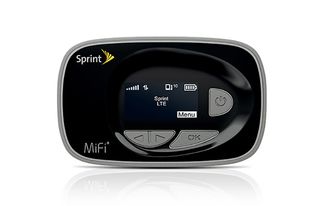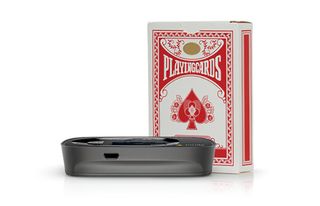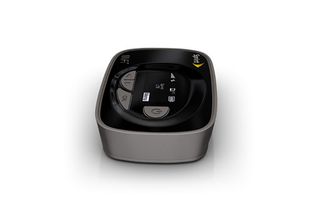Laptop Mag Verdict
The Sprint MiFi 500 LTE Hotspot offers good battery life and fast data speeds where Sprint LTE coverage is available.
Pros
- +
Light design
- +
Strong 4G speeds
- +
Simple interface
- +
Long battery life
Cons
- -
Limited Sprint LTE coverage
Why you can trust Laptop Mag
Though late to the 4G LTE party, Sprint is busy adding cities to its rollout, with 151 markets currently covered and more to come. Users who want to get their laptops, tablets and other devices onto this growing high-speed network have a compelling choice in the new MiFi 500 LTE. This lightweight and easy-to-use mobile hotspot is free with a two-year contract and lasts all day on a charge.
Design

Click to EnlargeMade by Novatel, the MiFi 500 LTE has a simple but functional aesthetic, with a gray plastic back and sides, a glossy top surface with a monochrome status screen and four simple buttons: left arrow, right arrow, power and OK. At 3.8 X 2.4 X 0.7 inches and 3.35 ounces, the MiFi 500 LTE is small enough to fit in even the smallest pocket, and it's a bit more compact than Sprint's other LTE hotspot, the 2.7 x 4.3 x 0.6-inch, 3.95-ounce Netgear Zing.
MORE: Best Laptops 2013
Interface

Click to EnlargeThe MiFi 500's on-device UI is pretty straightforward, with a basic home screen that shows the battery status, number of attached devices and network connectivity. The local menu allows you to see (but not change) the password, get a list of IP addresses for every device and check for software updates. The Mobile Network submenu allows you to switch between LTE-preferred, LTE-only, 3G-preferred and 3G-only modes. When we found the device connecting to 3G with it set to LTE-preferred mode, we changed the setting to LTE-only and managed to connect to Sprint's LTE network.
If you want to change the Wi-Fi password, limit the number of devices, control how long the screen stays on or enable the MiFi 500 to share location data with devices, you must enter the Web interface in your browser. Although that interface provides more control over the hotspot, it's also fairly spartan, with just a handful of buttons and tabs to click.
Our favorite setting that's exclusive to the Web interface is Stealth mode, which disables all lights on the MiFi 500, including the blinking status light, so that other people won't know it's on. This feature could come in handy when you don't want to disturb or distract others around you.
MORE: 10 Pieces of Paid Software That Are Now Free
Performance

Click to EnlargeThe MiFi 500 LTE provides strong 4G speeds that are consistent with those on other devices in Sprint's LTE network. On the east side of Manhattan, in an area with strong LTE coverage, the hotspot provided an average download speed of 7.2 Mbps and upload speed of 3.4 Mbps on Speedtest.net. The Sprint version of the Samsung Galaxy S4 got similar scores (8.6 Mbps down / 2.5 Mbps up) when we tested it previously in the same location, but the LG Optimus F3 did better when we tested it on the Upper West Side of Manhattan, notching marks of 10.6 Mbps down and 5.9 Mbps up.
We've seen stronger average speeds in the past from such Verizon hotspots as the Jetpack 5510L, which got an average download speed of 21.75 Mbps and upload speed of 10.02 Mbps. However, AT&T's MiFi Liberate was a bit weaker in Manhattan, providing average speeds of 5.9 Mbps down and 4.7 Mbps up.
However, in a real-world downloading test, the MiFi 500 really shined. It took just 1 minute and 51 seconds to download the 140MB OpenOffice installer. That's less than half the time the Verizon Jetpack took (6:27) and just a quarter of the time the AT&T MiFi Liberate took in its fastest location (8:00).
MORE: 15 PC-Cleaning Tools to Speed Your Computer
Battery Life

Click to EnlargeWith its 1,800 mAH battery, the MiFi 500 lasts through an entire workday of continuous use. That's impressive, but not as strong as some competitors. When we connected a PC to the MiFi 500 and programmed it to surf the Web continuously, it took 7 hours and 59 minutes for the hotspot to run out of juice. AT&T's MiFi Liberate lasted 8 hours and 26 minutes on our test, while the Verizon Jetpack 5510L endured for an epic 14 hours and 43 minutes.
Coverage
As of this writing, Sprint blankets 151 U.S. markets with its 4G LTE signal. Some of the larger cities include Los Angeles, Miami, Dallas and Boston. However, though we tested our MiFi 500 in Manhattan, only the Bronx and Brooklyn are officially listed by Sprint as covered markets. Users who want more thorough nationwide coverage should consider AT&T or Verizon, both of which cover all the major metropolitan areas.
Value
Sprint's hotspot data plans start at $34.99 for 3GB of monthly data and rise up to $49.99 for 6GB and $79.99 for 12GB. Verizon charges $30 per month plus a $20 line charge (for a total of $50/month) for 4GB of data on its LTE network, while AT&T charges $50 for its 5GB plan. Users who are happy with a modest amount of monthly data should consider Sprint's 3GB plan, while those who plan to download a lot of media files will want the 6GB plan that adds up to a reasonable $8.33 per GB.
Verdict

Click to EnlargeThe Sprint MiFi 500 doesn't have the flashy touch-screen interface of the AT&T MiFi Liberate or the mind-blowingly long battery life of the Verizon Jetpack 5510L, but it still has a lot to offer Sprint customers. With a simple, easy-to-use menu; a lightweight body; and fast download speeds, this free hotspot is a great deal. Users looking for even faster speeds and even longer endurance should consider the Jetpack 5510L, which rides on Verizon's larger network but costs more per month. However, if you have Sprint LTE coverage in your area, the MiFi 500 should be at the top of your list.
Sprint MiFi 500 LTE Specs
| Company Website | www.sprint.com |
| Size | 3.8" X 2.4" X 0.7" |
| Weight | 3.35 ounces |
